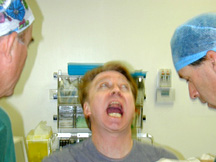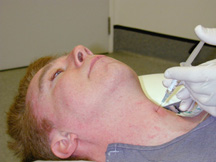 "AWAKE" INTUBATION "AWAKE" INTUBATION  You will not be wide awake for this procedure, despite the name! The anaesthetist will establish an intravenous line and give you some sedation, most commonly midazolam or a similar agent, with maybe another drug or two. You probably won't remember a thing about it, although it is possible you may have some hazy recollection. Being difficult to intubate for previous anaesthesia and surgery, I had an awake intubation recently ( I had an anti-reflux operation called a fundoplication, done through the laparoscope ). As an anesthesiologist, I was curious to experience some of the procedure from the other side, so I asked my anaesthetist to go easy on the sedation. As he is the local guru for airway management, I knew he would be skillful yet gentle in getting me intubated without much trauma, and I was right ; ) One secret for success is generous use of local anaesthetic to the lining of your airways, which are very sensitive. This also prevents you from coughing and gagging, which can make the procedure very awkward. Usually you will gargle some local anaesthetic gel or liquid ( see me doing this below left ! ) A mist or spray of concentrated local anaesthetic is often given. If you are having a "nasal" intubation, the tube goes through one nostril and curves around the back of your throat, entering the larynx from above. Here you may have a nasal spray, or some topical solution or gel applied with cotton buds / Q-tips. Cocaine is often used for this, but it doesn't have the same effect you see in the movies! |
||
 
You may have an injection with a fine needle around the nerves in the neck which supply the upper larynx, or a direct injection into the trachea just below the Adam's apple - called a cricothyroid injection ( above right ). This can make you cough for a moment, but it gives excellent local anaesthesia for the rest of the procedure. Once the airway is topically anesthetised the tube should pass through the larynx easily. It may take longer if there is bleeding ( most commonly from the nose ) , but the local anaesthetic contains a "vasoconstrictor" or blood vessel narrowing agent which lessens this risk. |
||
| page 5 contact us join mailing list |